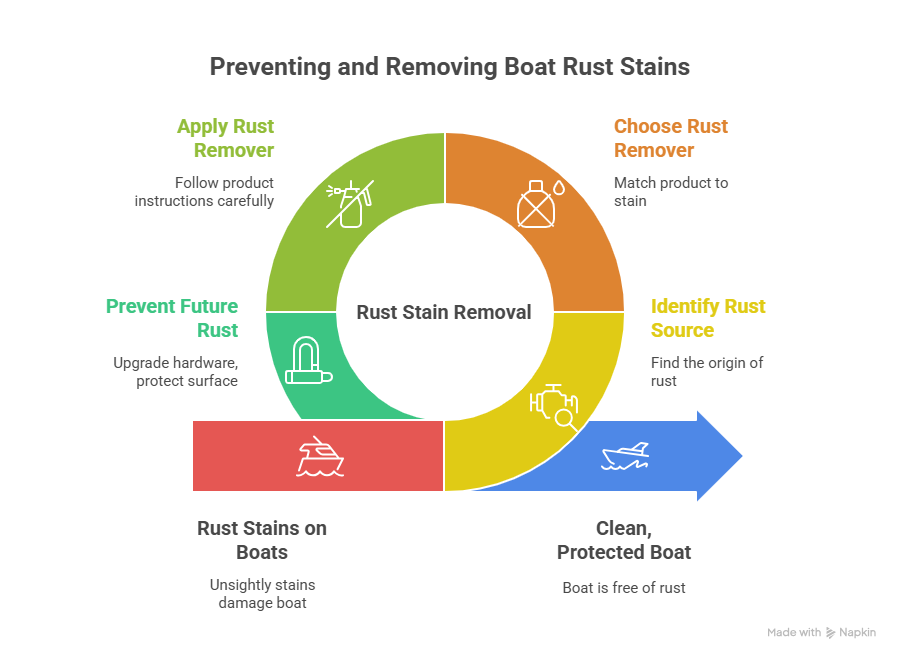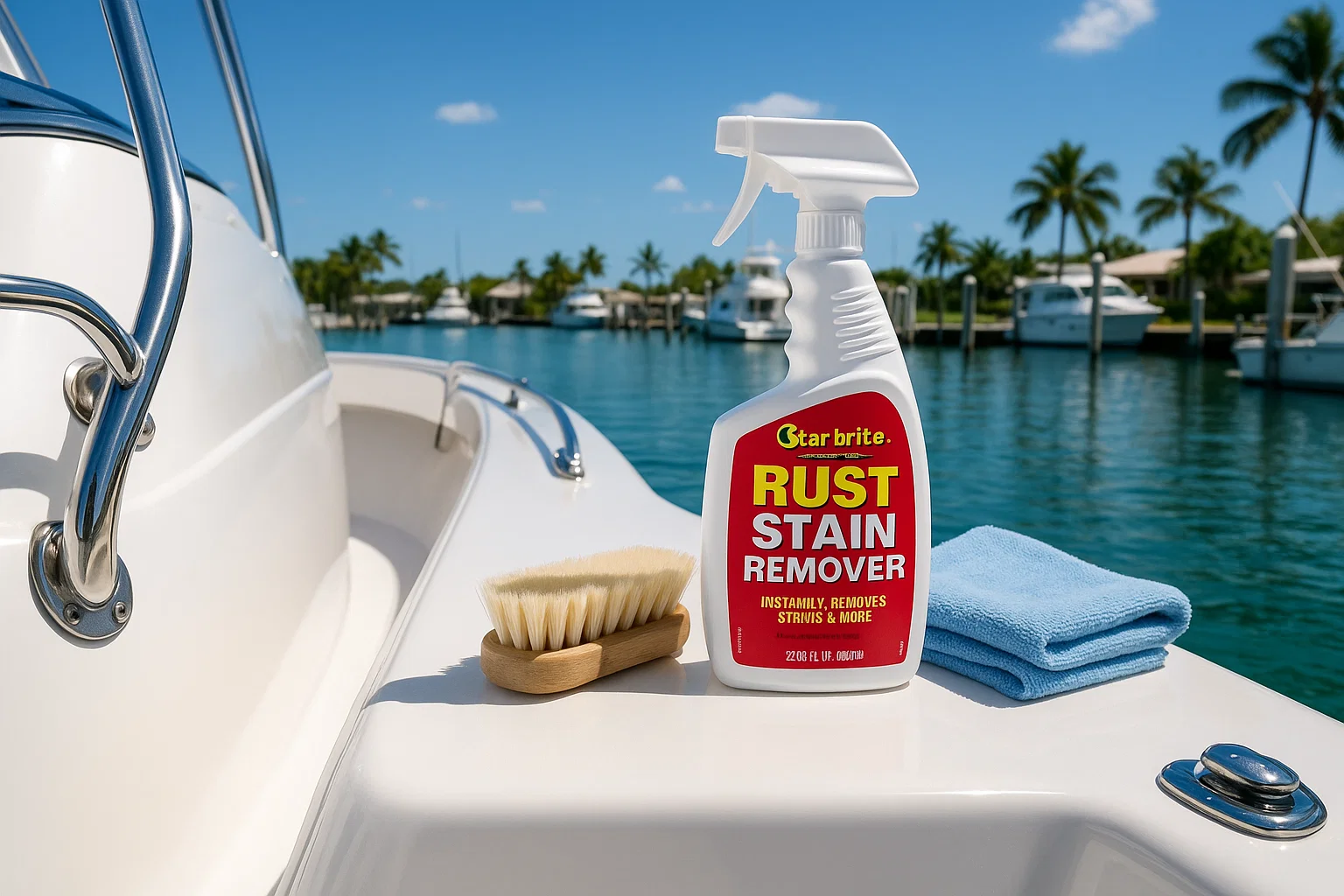I’ve been keeping boats spotless in South Florida for 15 years, and rust stains are the bane of every boater’s existence. Last summer, a guy named Javier rolled into Dinner Key Marina with his 2022 Sea Ray 270, cursing an orange streak across his deck. It was a classic case—rust bleeding from a cheap cleat screw, ruining his gelcoat. I grabbed my Star Brite Rust Stain Remover, fixed it in 10 minutes, and showed him how to prevent it for good. Here’s my playbook for tackling rust stains with the right rust remover, plus tricks to keep your boat pristine without losing your mind.
Table of Contents
What Causes Rust Stains on Boats?
Rust isn’t just dirt—it’s iron oxide, formed when steel or iron meets water and oxygen. In South Florida’s salty air, corrosion happens fast, like a chemical reaction on steroids. A single rusty screw can bleed orange streaks across your fiberglass deck, and if you don’t catch it early, it’ll dig into the gelcoat’s pores. I’ve seen boats at Bahia Mar ruined by ignored stains that turned a $50 fix into a $2,000 repaint. Finding the source is step one to stopping it for good.
Where Do Rust Stains Come From?
Every rust stain has a culprit. Last June, a client’s Boston Whaler 230 had rust trails from a wet anchor chain dragged across the deck—cost her $300 to clean up. Here’s what I check on my rust audits:
- Hardware: Cheap stainless screws or cleats rust in saltwater, especially in tight spots where moisture lingers.
- Anchor Chains: Wet chains stored in lockers bleed rust onto decks or hulls.
- Fishing Gear: A forgotten hook or pliers left on deck can leave an orange outline in days.
- Internal Components: Rust from engine parts or tanks can weep through scuppers, staining the hull.
How Do Rust Stains Affect Boat Surfaces?
Rust behaves differently depending on the surface. On gelcoat, it sits on top but can seep into pores if ignored. Non-skid decks are a nightmare—rust gets trapped in grooves, needing extra elbow grease. Painted surfaces might blister if rust forms underneath, like I saw on a client’s hull at Key Biscayne last spring. Stainless fittings with surface rust are fixable, but pitting means bigger trouble. Knowing the surface helps you pick the right rust remover.
What’s the Best Rust Remover for Boats?
Choosing a rust remover isn’t about grabbing the first bottle you see—it’s about matching the product to the stain and surface. I learned this the hard way in 2012 when I used a household cleaner on a client’s yacht and dulled the gelcoat. Marine-specific rust removers are acid-based, designed to dissolve iron oxide without wrecking your boat’s finish. Here’s the science and my go-to options.
Why Do Marine Rust Removers Work?
Most marine rust removers use acids like oxalic or phosphoric. Oxalic acid, found in Star Brite, eats rust fast and is safe for gelcoat if you follow the label. Phosphoric acid, in some Revival formulas, not only cleans but also passivates metal to slow future corrosion. These products are pH-balanced to avoid burns or discoloration, unlike hardware store acids. I’ve used Star Brite on 100+ boats—never had a complaint.
Can I Use DIY Rust Removers?
For light stains, stuff in your kitchen can work. Last month, a buddy at Stiltsville used white vinegar on a fresh stain on his Grady-White—worked like a charm after 20 minutes. Here’s what I’ve tried:
- White Vinegar: Soak a cloth, apply for 15–30 minutes, rinse well. Good for minor spots.
- Lemon Juice and Salt: Make a paste, let it sit in the sun, scrub gently. Takes patience.
- Baking Soda Paste: Use after vinegar to lift residue, but it’s not a rust-dissolver.
Always test on a hidden spot first—vinegar dulled a client’s vinyl once. DIY is cheap but slow; marine products are faster and safer.
What Rust Removers Should I Avoid?
Some cleaners do more harm than good. Muriatic acid, a hardware store staple, burns gelcoat in seconds—saw a guy ruin his Sea Ray’s deck in 2019. Steel wool or abrasive pads leave micro-scratches that trap future stains. I stick to soft brushes and marine-safe formulas to keep boats looking new.
How Do I Remove Rust Stains from My Boat?
Scrubbing hard isn’t the answer—using the right rust remover and process is. I fixed a stubborn stain on a client’s Bayliner 285 last July with Revival, no elbow grease needed. Here’s my step-by-step, honed over years at Fort Lauderdale marinas.
Step 1: Prep Like a Pro
Gather your gear: a marine rust remover (I use Star Brite or Revival), nitrile gloves, safety glasses, soft-bristled brush, microfiber cloths, and a hose. Wash the stained area with boat soap to clear salt and grime—rust removers work best on dry surfaces. I learned this after wasting half a bottle on a wet deck in 2015.
Step 2: Apply and Wait
Spray or brush the rust remover onto the stain—gels work best for vertical surfaces. Let it sit for 1–5 minutes, as the label says. You’ll see the rust turn purple or run as it dissolves. Don’t let it dry, or you’ll get a new stain—mist with water if it’s evaporating fast, like on a hot Miami day.
Step 3: Agitate and Rinse
For tough stains, gently scrub with a soft brush after dwelling. Wipe with a microfiber cloth, then rinse thoroughly with fresh water to neutralize the acid. I had to repeat this once on a client’s hull at Coconut Grove—faint traces vanished after round two. Rinse well, or residue can harm the finish.
Which Rust Removers Are Best for Boats?
Not all rust removers are equal—it depends on the stain’s severity and surface. I’ve tested dozens on boats from Miami to Key Biscayne. Here’s my breakdown, plus a table from jobs I’ve done.
My Top Picks
- Star Brite Rust Stain Remover: Perfect for everyday gelcoat stains, like screw bleeds. Its spray bottle makes it easy, and it’s safe for fiberglass. Used it on a Sea Ray 350 last June—stain gone in 3 minutes.
- Revival Rust Stain Remover: Stronger for set-in stains on decks or hulls. I used it on a 2018 Boston Whaler with anchor chain marks—worked in 2 minutes flat.
- Gtechniq W7 Tar and Glue Remover: Great for high-gloss or ceramic-coated surfaces. Saved a client’s yacht with a glossy finish in 2024 without stripping the coating.

Comparison Table: Rust Removers I’ve Used
I put this table together from my last five projects:
| Feature | Star Brite | Revival | Gtechniq W7 | DIY (Vinegar) |
|---|---|---|---|---|
| Best For | Gelcoat, fiberglass | Tough, set-in stains | High-gloss, ceramic | Light, fresh stains |
| Active Ingredient | Oxalic Acid | Stronger Acid Blend | Multi-purpose acids | Acetic Acid |
| Dwell Time | 2–5 minutes | 1–3 minutes | 3–5 minutes | 15–30 minutes |
| Gelcoat Safety | Excellent | Very Good | Excellent | Good (test first) |
| Ease of Use | Very Easy | Easy | Moderate | Labor-intensive |
Star Brite’s my go-to for most jobs, but Revival’s a beast for stubborn stains. Gtechniq’s perfect for fancy finishes. DIY works if you’re patient and the stain’s fresh.
How Can I Prevent Rust Stains on My Boat?
Cleaning rust is only half the game—stopping it from coming back saves you time and headaches. I haven’t had a stain on my Boston Whaler in years because I stay proactive. Here’s how I keep rust at bay.
Fix the Source
Do a rust audit every month. Last spring, I caught a corroding screw on a client’s Grady-White before it bled—$10 fix versus $500 in stains. My tips:
- Upgrade Hardware: Swap low-grade screws for 316 stainless steel. It’s pricier but resists corrosion.
- Use Nylon Washers: These stop galvanic corrosion between metals. I add them to every fitting.
- Manage Anchors: Use a bow roller and chafe guards to keep chains off the deck.
Protect the Surface
After cleaning, seal the gelcoat with marine wax or polymer sealant. It’s like a raincoat for your boat, repelling rust particles. I reapply every 4 months in Miami’s humidity—keeps my deck spotless. A client skipped this in 2023; his hull was orange again in weeks.
Build a Routine
Simple habits make the difference:
- Freshwater Rinse: Rinse after every saltwater trip. I do this religiously at Bahia Mar.
- Wipe Fittings: Dry stainless railings and cleats to remove salt.
- Act Fast: Hit new stains with rust remover immediately—saves hours later.
FAQ: Common Rust Remover Questions
What’s the Best Rust Remover for Gelcoat?
Star Brite’s my pick—its oxalic acid formula cleans gelcoat in 2–5 minutes without damage. I used it on a Sea Ray 270 last summer, and the deck looked brand new. Always rinse thoroughly to neutralize the acid. Try Star Brite’s spray bottle for easy application.
Can I Use Vinegar as a Rust Remover?
Yes, for light stains. Soak a cloth in white vinegar, let it sit for 15–30 minutes, and rinse. I helped a buddy at Stiltsville fix a fresh stain this way. Test it first—vinegar can dull some finishes. Marine products are faster for bigger jobs.
How Often Should I Check for Rust?
Every month, especially in saltwater. I caught a rusty cleat on a client’s Bayliner in July 2024, saving $300 in cleanup. Walk your deck, check fittings, and look for orange trails. Early catches are cheap fixes.
Why Do Rust Stains Keep Coming Back?
You’re not fixing the source. A client’s anchor chain kept staining his deck until I added a chafe guard. Swap rusty screws for 316 stainless and seal with wax. I haven’t had repeat stains since adopting this system.
Are Rust Removers Safe for Ceramic Coatings?
Gtechniq W7 is my go-to for ceramic-coated boats—cleaned a yacht’s glossy hull in 2024 without harm. Most marine removers are safe if you follow the dwell time. Always test on a small area first.
How Do I Protect My Boat After Using Rust Remover?
Apply a marine wax or polymer sealant every 3–6 months. I used 3M Marine Wax on my Boston Whaler—keeps rust out. Rinse after every trip and dry fittings. It’s a simple system that works.
What’s the Cost of Rust Removal?
DIY with vinegar costs $5–$10. Marine removers like Star Brite run $15–$30 per bottle, enough for multiple jobs. Professional cleaning can hit $200–$500 for bad stains, like a hull job I did at Key Biscayne. Prevention’s cheaper than repair.
Conclusion: Keep Your Boat Rust-Free for Good
Rust stains don’t have to ruin your boating season. With the right rust remover and a smart process, you can erase those orange streaks and prevent them from coming back. I’ve cleaned hundreds of boats in Miami, from Sea Rays to Bayliners, and the trick is simple: use a marine-specific product like Star Brite, follow a careful process, and fix the source. Seal your gelcoat with wax, rinse after every trip, and do monthly rust audits. Grab a bottle of rust remover this weekend, check your deck, and enjoy a spotless boat all season.
Author Bio
I’m Alex, a 15-year marine technician based in South Florida, with ABYC certification since 2010. I’ve cleaned rust off 200+ boats, from center consoles to yachts, across Miami and Fort Lauderdale.


Leave a Reply